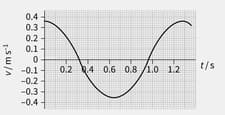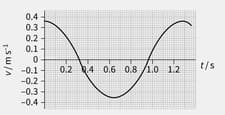A trolley of mass Is fixed to the end of a spring. The spring can be compressed and extended. The spring has a force constant . The other end of the spring is attached to a vertical wall. The trolley lies on a smooth horizontal table. The trolley oscillates when it is displaced from its equilibrium position. Show that the motion of the oscillating trolley is S.H.M.

Important Questions on Oscillations
A trolley of mass Is fixed to the end of a spring. The spring can be compressed and extended. The spring has a force constant . The other end of the spring is attached to a vertical wall. The trolley lies on a smooth horizontal table. The trolley oscillates when it is displaced from its equilibrium position. Show that the period Of the trolley is given by the equation: .
To start a pendulum swinging, you pull it slightly to one side.
What kind of energy does this transfer to the mass?
To start a pendulum swinging, you pull it slightly to one side. Describe the energy changes that occur when the mass is released.
Figure shows how the different forms of energy change with displacement during s.h.m. Copy the graph, and show how the graph would differ if the oscillating mass were given only half the initial input of energy.
Figure shows how the velocity of a mass was found to vary with time during an investigation of the s.h.m. of a pendulum. Use the graph to estimate the following for the mass: Its maximum velocity

Figure shows how the velocity of a mass was found to vary with time during an investigation of the s.h.m. of a pendulum. Use the graph to estimate the following for the mass: Its maximum kinetic energy.

Figure shows how the velocity of a mass was found to vary with time during an investigation of the s.h.m. of a pendulum. Use the graph to estimate the following for the mass: Its maximum potential energy

Figure shows how the velocity of a mass was found to vary with time during an investigation of the s.h.m. of a pendulum. Use the graph to estimate the following for the mass: Its maximum acceleration


